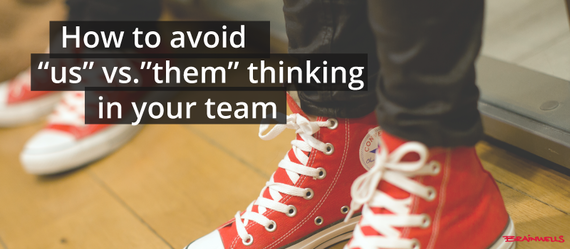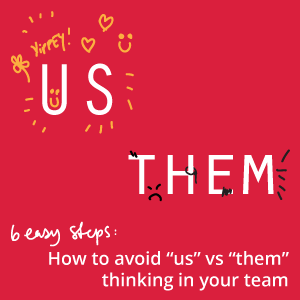
Most of us like working together as part of a team. There is the bond of a shared goal. Collaboration. Respect for one another. It can be productive and fulfilling. But NOT if it is at the expense of the company at large.
This week we address the "us" vs "them" issue in response to a question from one of the leaders who reads our blog, LeadershipCourageFun! Feel free to share your experiences, too. You know - together we are a well of knowledge.

"I wonder if you could give me some advice on how to avoid the "us" vs. "them" mentality on our team? I recently started a new role as principal of a hi-tech company. It's an exciting and challenging position. There is a lot of potential. After only a few weeks into my new job, I realized there was a strong sense of "us " and "them" division in the organization. It would have been ok if the "us" were all of us, and the "them" was our competitor. Sadly, that is not the case. The "us" and "them" scenario divides the entire company in two: The sales/marketing-people on one side; tech/development-staff on the other. Neither acknowledges the important job the "other" plays in order to mutually succeed. It saddens me to see how much energy we spend on working against each other, instead of fighting the everyday challenges together. What do you suggest I do?
A: First - we totally agree with your concern that this is an important adjustment to make in order to succeed. The reason why we end up in a situation like this? It is a result of the power of in-group bias. "People tend to hold positive attitudes towards members of their own groups." Thank you, Wikipedia.
Rivalry and competition in an organization can be positive. The question is whether it is done in friendly ways that accelerate improvement and performance. Or is it a negative force that fosters uncertainty and lack of trust?
It boils down to a matter of culture. Or more precisely, the lack of defining a culture that is good for the organization. The problem in this case is that subgroups within a group have established an internal cultural code that is stronger than the core group they all belong to. And you're totally right, the full potential of the core group (your organization) suffers.
Changing cultural behaviors takes time and persistence, but it is possible. You should look at it like a process. There is a starting point, short- and long-term objectives, and a moveable finish line so you can make adjustments as you go. If you are confident in facilitating involving processes, you can do this yourself. If not, hire a facilitator to help you.
- Do not do this alone. Bring your concern to your executive team. If you do not have an executive team, assemble a task force with people who recognize the need to do things differently. Let them know why you want to start this process, how you are going to do it and that you need their support.
- Find an external "enemy." Use this group to look at your company's situation and define/establish some external treats. Directing awareness toward a mutual, external "enemy" often builds the necessary momentum for a change.
- Let your employees know that you expect them to join forces in order to "fight" this challenge - together. Let them understand how you see the situation. Know that it might not always be easy to collaborate and support each other. But that is the goal.
- Engage people. Perform workshops where you gather people from different parts of the organization. Try to find solutions to questions like "What actions can we take to build a strong mutual team?", "What positive aspects of the culture do we want to see more of?", "What kind of behavior do we accept (and what do we not tolerate)" etc. Focus on the positive outcome. Let them decide on the next steps that can be implemented immediately.
- Who are the boycotters? Be aware that you might have some people on your team who are actively disengaged. These are your boycotters. Talk to them one-on-one. Make it clear this is not acceptable. If they bully in public, confront them in public. Ask them what they are doing and why. This allows the rest of your team to see that you do not accept this kind of behavior. If nothing helps, find a way to replace them.
- The Progress Principle. Make sure to acknowledge your progress, celebrate your wins, and keep up the good work. Things will eventually change.
But don't forget to take a look in the mirror. Culture is contagious. The higher up in the organization, the more it influences. Whatever you want to change or strengthen in your organization, make sure you act as a guiding star. If you need more collaboration, ask your executive team to step up. Get everyone integrated and involved. After all, this is involving leadership.
This blog post is also published in the blog LeadershipCourageFun. It is written by Kristine Maudal and Even Fossen, founders of Brainwells and creators of the online leadership program FutureLeadershipNow.
We have a common passion for making the corporate world a better place, and do this by training executives and executive teams in how to become Involving Leaders. Daily we experience magic moments when people exceed their own expectations due to new insights and skills. With love and care we'll share this magic with you. Thank you for being here.
All photos © Brainwells
